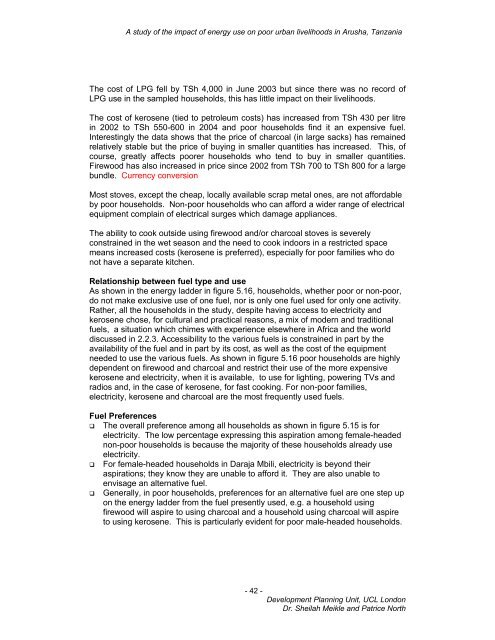The Impact of Energy Use on Poor Urban Livelihoods in ... - DfID
The Impact of Energy Use on Poor Urban Livelihoods in ... - DfID
The Impact of Energy Use on Poor Urban Livelihoods in ... - DfID
You also want an ePaper? Increase the reach of your titles
YUMPU automatically turns print PDFs into web optimized ePapers that Google loves.
A study <str<strong>on</strong>g>of</str<strong>on</strong>g> the impact <str<strong>on</strong>g>of</str<strong>on</strong>g> energy use <strong>on</strong> poor urban livelihoods <strong>in</strong> Arusha, Tanzania<br />
<str<strong>on</strong>g>The</str<strong>on</strong>g> cost <str<strong>on</strong>g>of</str<strong>on</strong>g> LPG fell by TSh 4,000 <strong>in</strong> June 2003 but s<strong>in</strong>ce there was no record <str<strong>on</strong>g>of</str<strong>on</strong>g><br />
LPG use <strong>in</strong> the sampled households, this has little impact <strong>on</strong> their livelihoods.<br />
<str<strong>on</strong>g>The</str<strong>on</strong>g> cost <str<strong>on</strong>g>of</str<strong>on</strong>g> kerosene (tied to petroleum costs) has <strong>in</strong>creased from TSh 430 per litre<br />
<strong>in</strong> 2002 to TSh 550-600 <strong>in</strong> 2004 and poor households f<strong>in</strong>d it an expensive fuel.<br />
Interest<strong>in</strong>gly the data shows that the price <str<strong>on</strong>g>of</str<strong>on</strong>g> charcoal (<strong>in</strong> large sacks) has rema<strong>in</strong>ed<br />
relatively stable but the price <str<strong>on</strong>g>of</str<strong>on</strong>g> buy<strong>in</strong>g <strong>in</strong> smaller quantities has <strong>in</strong>creased. This, <str<strong>on</strong>g>of</str<strong>on</strong>g><br />
course, greatly affects poorer households who tend to buy <strong>in</strong> smaller quantities.<br />
Firewood has also <strong>in</strong>creased <strong>in</strong> price s<strong>in</strong>ce 2002 from TSh 700 to TSh 800 for a large<br />
bundle. Currency c<strong>on</strong>versi<strong>on</strong><br />
Most stoves, except the cheap, locally available scrap metal <strong>on</strong>es, are not affordable<br />
by poor households. N<strong>on</strong>-poor households who can afford a wider range <str<strong>on</strong>g>of</str<strong>on</strong>g> electrical<br />
equipment compla<strong>in</strong> <str<strong>on</strong>g>of</str<strong>on</strong>g> electrical surges which damage appliances.<br />
<str<strong>on</strong>g>The</str<strong>on</strong>g> ability to cook outside us<strong>in</strong>g firewood and/or charcoal stoves is severely<br />
c<strong>on</strong>stra<strong>in</strong>ed <strong>in</strong> the wet seas<strong>on</strong> and the need to cook <strong>in</strong>doors <strong>in</strong> a restricted space<br />
means <strong>in</strong>creased costs (kerosene is preferred), especially for poor families who do<br />
not have a separate kitchen.<br />
Relati<strong>on</strong>ship between fuel type and use<br />
As shown <strong>in</strong> the energy ladder <strong>in</strong> figure 5.16, households, whether poor or n<strong>on</strong>-poor,<br />
do not make exclusive use <str<strong>on</strong>g>of</str<strong>on</strong>g> <strong>on</strong>e fuel, nor is <strong>on</strong>ly <strong>on</strong>e fuel used for <strong>on</strong>ly <strong>on</strong>e activity.<br />
Rather, all the households <strong>in</strong> the study, despite hav<strong>in</strong>g access to electricity and<br />
kerosene chose, for cultural and practical reas<strong>on</strong>s, a mix <str<strong>on</strong>g>of</str<strong>on</strong>g> modern and traditi<strong>on</strong>al<br />
fuels, a situati<strong>on</strong> which chimes with experience elsewhere <strong>in</strong> Africa and the world<br />
discussed <strong>in</strong> 2.2.3. Accessibility to the various fuels is c<strong>on</strong>stra<strong>in</strong>ed <strong>in</strong> part by the<br />
availability <str<strong>on</strong>g>of</str<strong>on</strong>g> the fuel and <strong>in</strong> part by its cost, as well as the cost <str<strong>on</strong>g>of</str<strong>on</strong>g> the equipment<br />
needed to use the various fuels. As shown <strong>in</strong> figure 5.16 poor households are highly<br />
dependent <strong>on</strong> firewood and charcoal and restrict their use <str<strong>on</strong>g>of</str<strong>on</strong>g> the more expensive<br />
kerosene and electricity, when it is available, to use for light<strong>in</strong>g, power<strong>in</strong>g TVs and<br />
radios and, <strong>in</strong> the case <str<strong>on</strong>g>of</str<strong>on</strong>g> kerosene, for fast cook<strong>in</strong>g. For n<strong>on</strong>-poor families,<br />
electricity, kerosene and charcoal are the most frequently used fuels.<br />
Fuel Preferences<br />
� <str<strong>on</strong>g>The</str<strong>on</strong>g> overall preference am<strong>on</strong>g all households as shown <strong>in</strong> figure 5.15 is for<br />
electricity. <str<strong>on</strong>g>The</str<strong>on</strong>g> low percentage express<strong>in</strong>g this aspirati<strong>on</strong> am<strong>on</strong>g female-headed<br />
n<strong>on</strong>-poor households is because the majority <str<strong>on</strong>g>of</str<strong>on</strong>g> these households already use<br />
electricity.<br />
� For female-headed households <strong>in</strong> Daraja Mbili, electricity is bey<strong>on</strong>d their<br />
aspirati<strong>on</strong>s; they know they are unable to afford it. <str<strong>on</strong>g>The</str<strong>on</strong>g>y are also unable to<br />
envisage an alternative fuel.<br />
� Generally, <strong>in</strong> poor households, preferences for an alternative fuel are <strong>on</strong>e step up<br />
<strong>on</strong> the energy ladder from the fuel presently used, e.g. a household us<strong>in</strong>g<br />
firewood will aspire to us<strong>in</strong>g charcoal and a household us<strong>in</strong>g charcoal will aspire<br />
to us<strong>in</strong>g kerosene. This is particularly evident for poor male-headed households.<br />
- 42 -<br />
Development Plann<strong>in</strong>g Unit, UCL L<strong>on</strong>d<strong>on</strong><br />
Dr. Sheilah Meikle and Patrice North
















